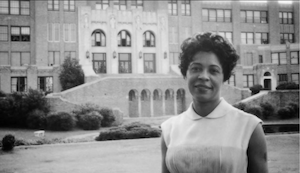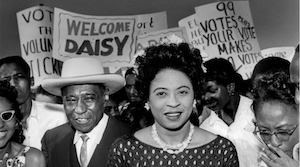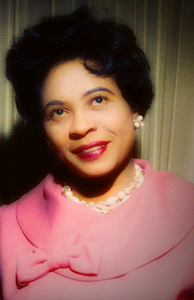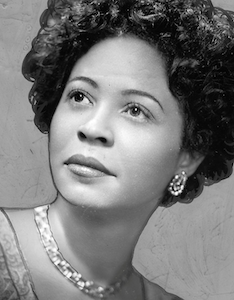
Daisy Lee Gatson Bates was one of the most significant civil rights leaders. She managed the Little Rock Nine integration and led the National Association for the Advancement of Colored People (NAACP), all while dealing with a great deal of harassment, violence, discrimination, and racism.
Bates was born on November 11, 1914 in Huttig, Arkansas. When she was young, her mother was violently murdered while resisting rape by three white men, and her father fled following that event. She was then adopted by friends of her parents. At the age of seven, she was denied service in a butcher shop because she was Black. She later described this incident by saying, “I knew I was a Negro, but I did not really understand what that meant until I was seven years old.” Discovering her parents’ true story and experiencing discrimination herself, Bates developed a passion to fight against racism.

At the age of 15, Bates met her future husband. The two leased a printing press and created a newspaper, the Arkansas State Press (ASP). The ASP advocated for civil rights, even before the movement was widespread or commonly recognized. They reported the police brutality and violence against Black citizens that occurred all too frequently. The ASP also assisted in telling the stories of returning Black WWII veterans who faced discrimination and violence. Regarding this issue, Bates once said, “The Negroes supposedly fighting a war in the name of freedom had through our paper found a voice to express their feelings.”
The story of a Black veteran killed by a white cop caused extreme uproar among white citizens. This resulted in a devastating loss of advertisement money, and a newspaper piece siding with striking workers that criticized a local judge led to Bates’s arrest and conviction. She was soon released, and her work supporting Black WWII veterans quickly gained recognition. The violence towards the veterans motivated the Civil Rights Movement and dramatically increased the membership of NAACP.

In 1952, Bates became leader of the state conference of NAACP branches. Two years after that, the ruling of Brown v. Board of Education fueled the NAACP, as they sued segregated schools. The Little Rock Central High School agreed to begin integration despite the efforts of Orval Faubus, a resisting segregationist. The Little Rock Nine, a group of nine Black students, attended Little Rock Central High School, and they quickly became a focal point of the NAACP.
Bates’s new role was to advise and protect the Little Rock Nine. As mobs threatened students and harassed activists and journalists, Bates accompanied the students to school. In the process, Bates was viciously attacked. She was threatened, hung in an effigy, had her house bombed, and had several guns left in her home. Crosses were burnt on her lawn, and missiles were thrown at her house. She even had to shut down the ASP because advertisers boycotted her newspaper.
However, despite these challenges, Bates remained an activist whose work on civil rights moved the country. For her incredible work, Bates was awarded the Woman of the Year by the National Council of Negro Women in 1957. She also won the Spingarn Medal, which was the NAACP’s highest and most distinguished award, in 1958.

Bates also wrote the book The Long Shadow of Little Rock, a memoir that recounted her many struggles during the integration crisis. The novel helped showcase the awe-inspiring strength of students and activists who made the integration possible.
After the integration of Little Rock, Bates moved to Washington D.C. She worked in the Democratic National Convention for Lyndon B. Johnson’s anti-poverty campaigns. However, in 1965, she was incapacitated by a stroke and was forced to give up the job.
She later donated papers, photographs, and documents from the Little Rock crisis to the State Historical Society of Wisconsin, and in 1984, she was able to produce another issue of the Arkansas State Press.
Bates earned a large number of awards for her incredible work and strength. She received an honorary Doctor of Laws degree from the University of Arkansas at Fayetteville. The Daisy Bates Elementary School was dedicated in Little Rock to commemorate her efforts. Moreover, in 1988, the Long Shadow of Little Rock was reprinted by the University of Arkansas, and it won the American Book Award–the first reprinted edition ever to earn the award. She was once called “the most distinguished Arkansas citizen of all time” by Bill Clinton, a fellow Arkansas citizen.
Bates died in 1999 due to a heart attack. After her death, she was awarded the Congressional Gold Medal by President Bill Clinton. She became the first African American to rest in-state at the Arkansas State Capitol Building. In February of 2012, 13 years after her death, the documentary “Daisy Bates: First Lady of Little Rock” aired on PBS. Her legacy continues, and she remains one of the most important activists for integration.
Why Did I Choose to Research Daisy Bates?
When I first learned about Daisy Bates, I was immediately inspired by her extreme courage and strength. The fact that she was able to continue with her work despite death threats and extreme incidents of harassment was incredible to me. I believe she should be thought of as a central Civil Rights Activist just as much as her incredible male counterparts.
Works Cited
"Daisy Bates." National Park Service, 1 Mar. 2021, www.nps.gov/people/dbates.htm. Accessed 31 July 2022.
"Daisy Lee Bates." Civil Rights in the United States, edited by Waldo E. Martin, Jr. and Patricia Sullivan, Macmillan Reference USA, 2000. Accessed 22 July 2022.
Nielsen, Euell A. "Daisy Lee Gatson Bates (1914-1999)." Blackpast, 22 Jan. 2007, www.blackpast.org/african-american-history/bates-daisy-1914-1999/. Accessed 31 July 2022.
This article was published on 2/1/23